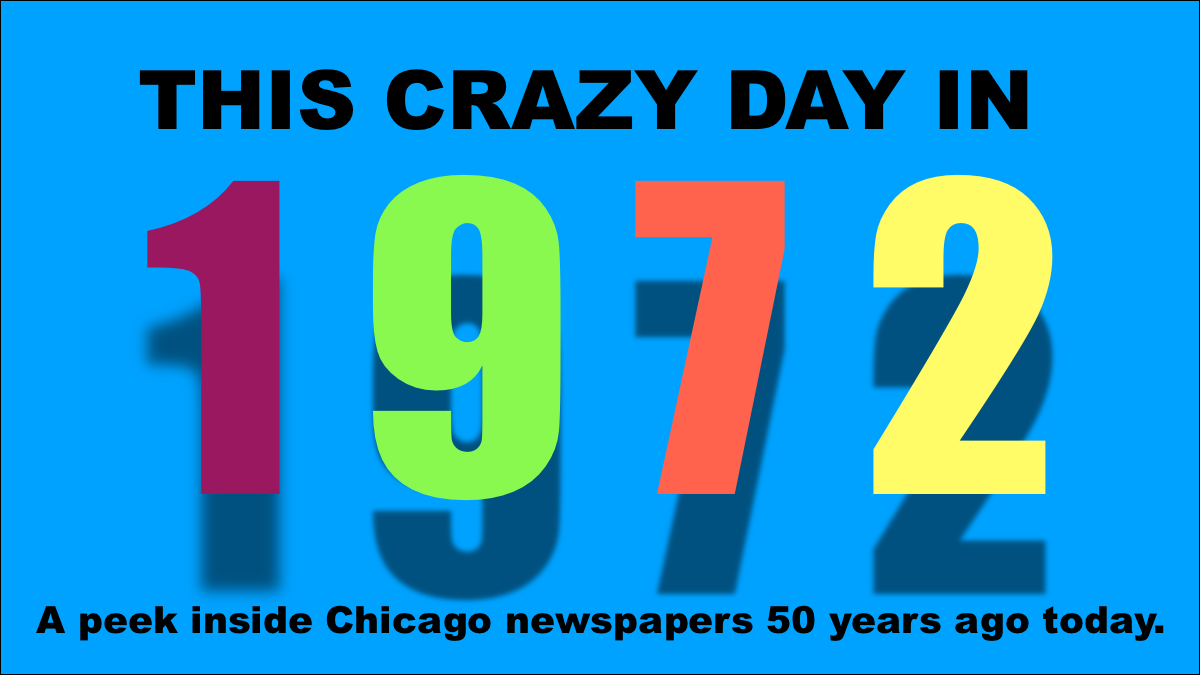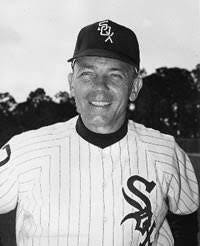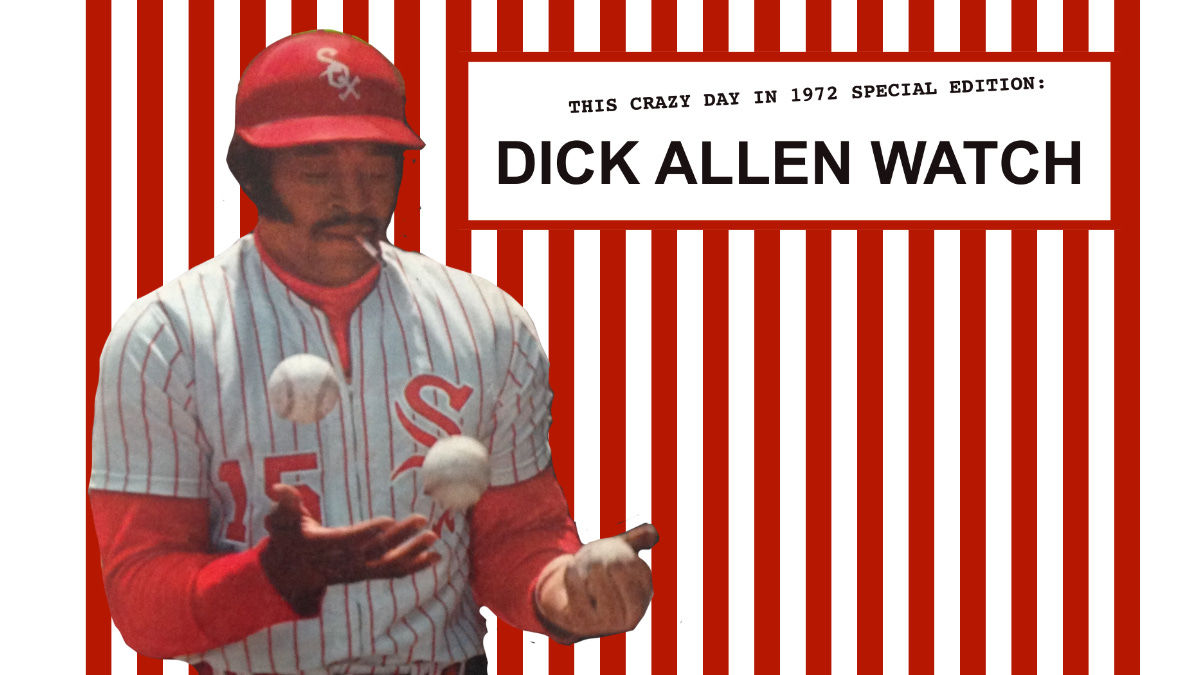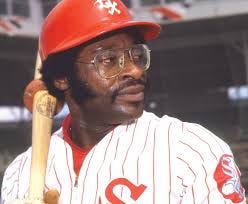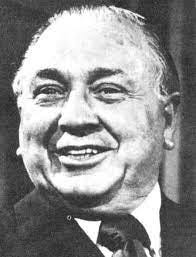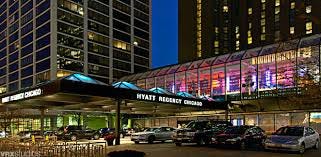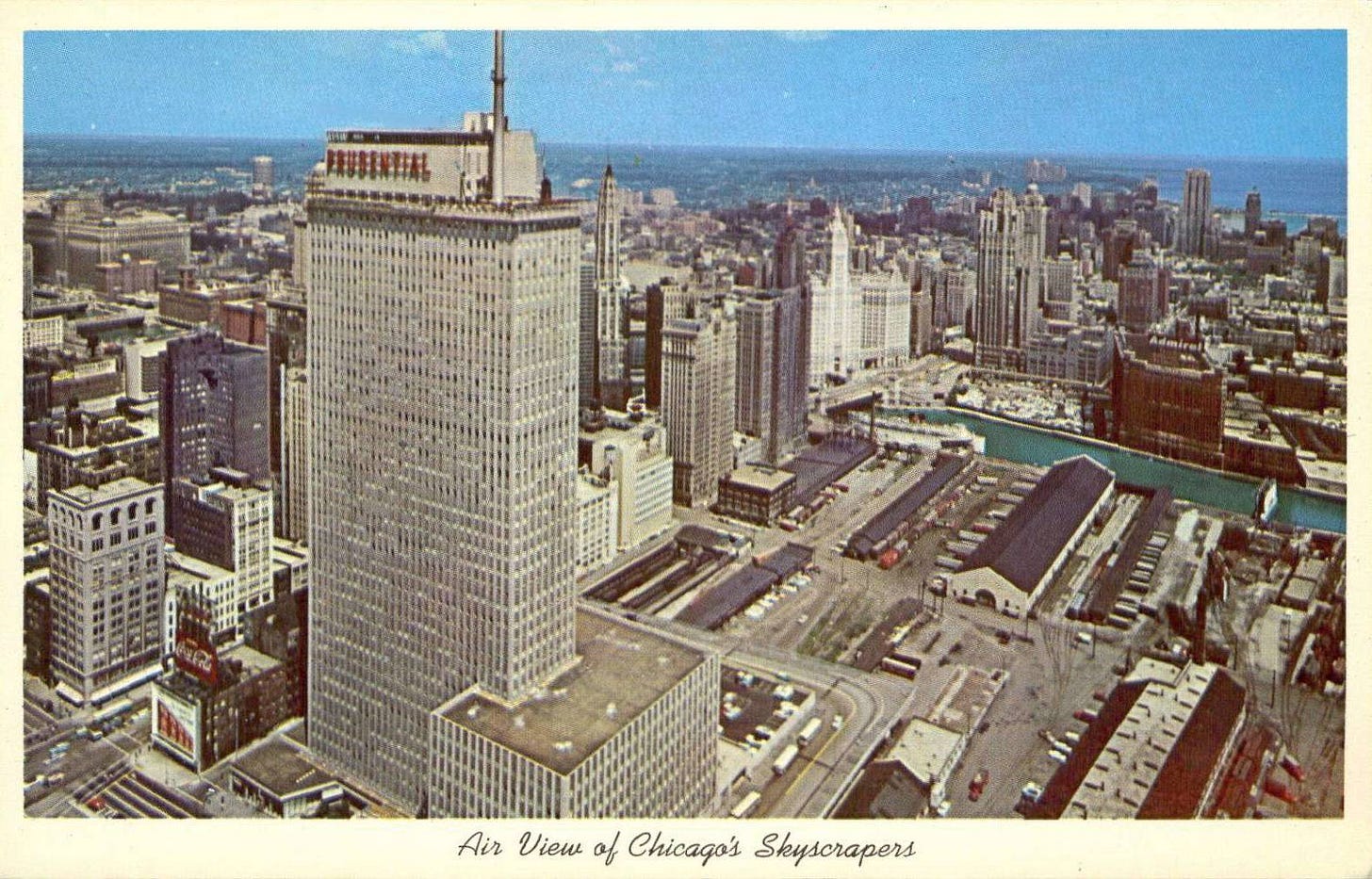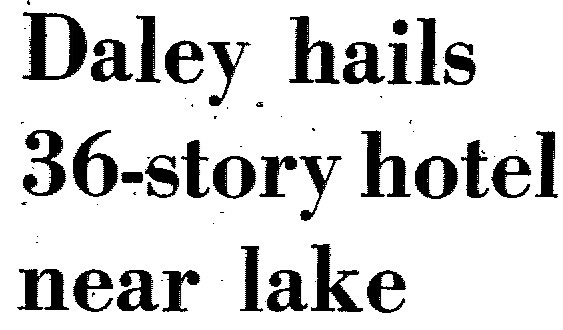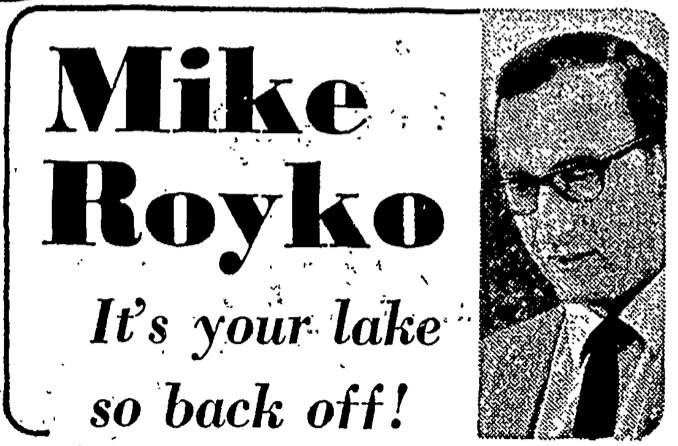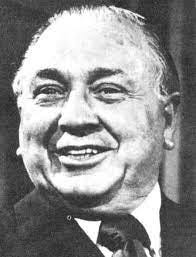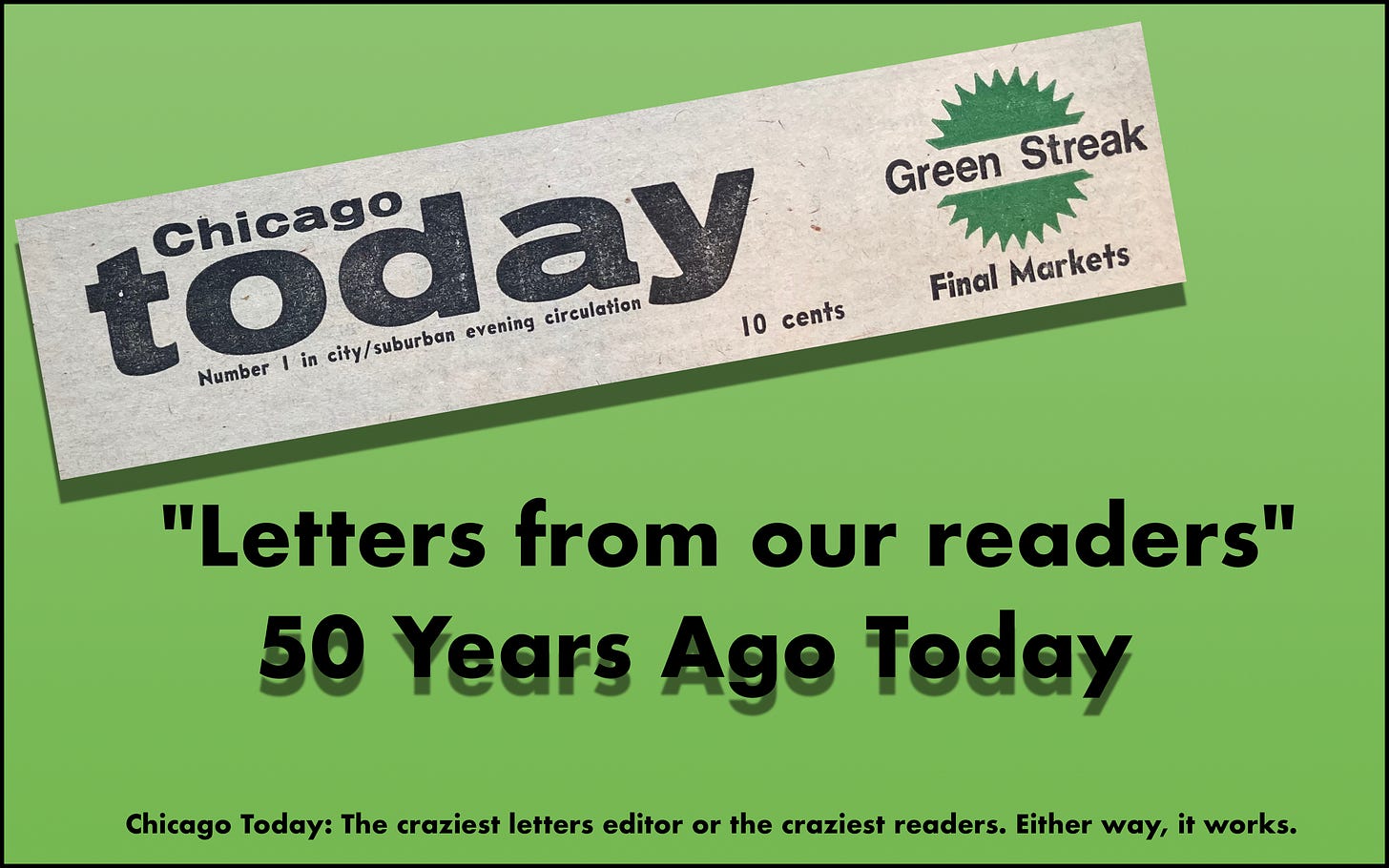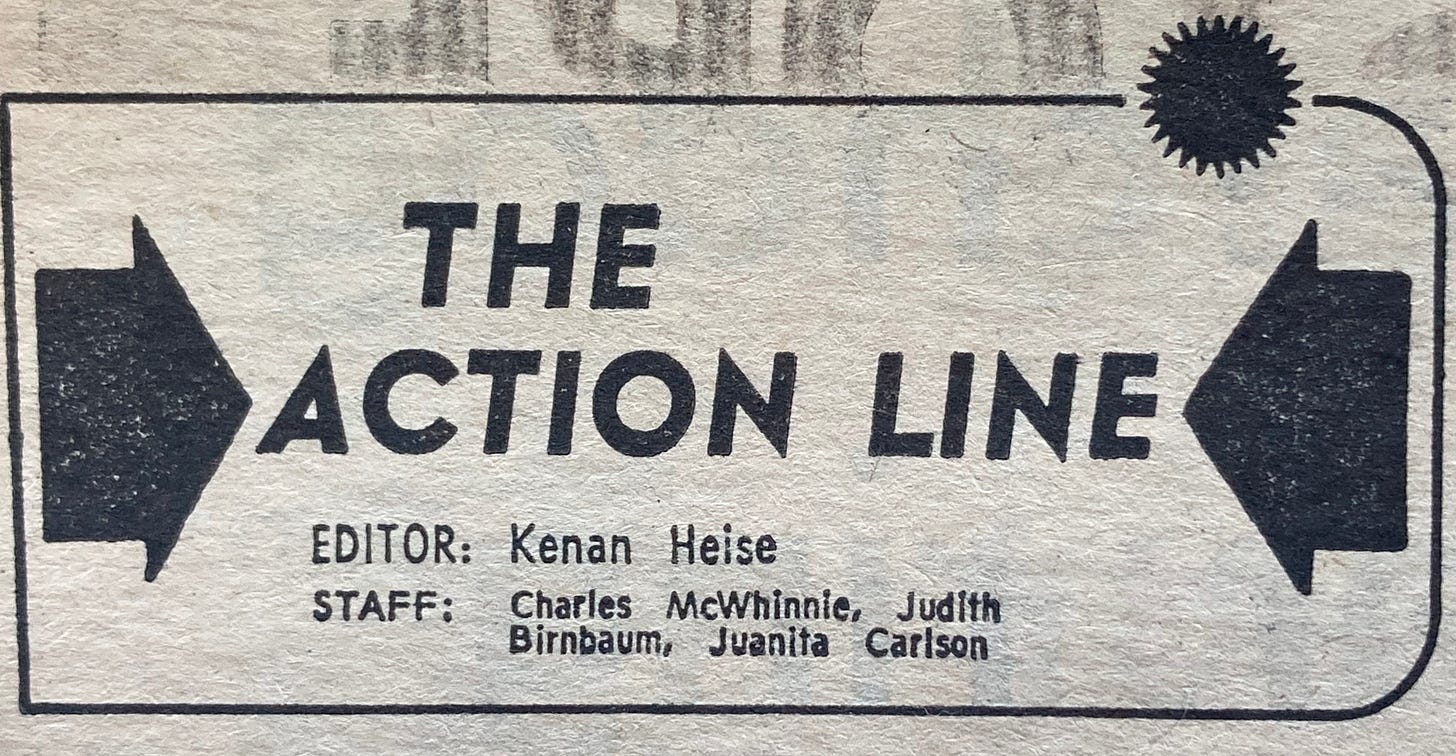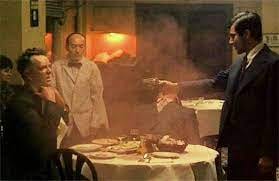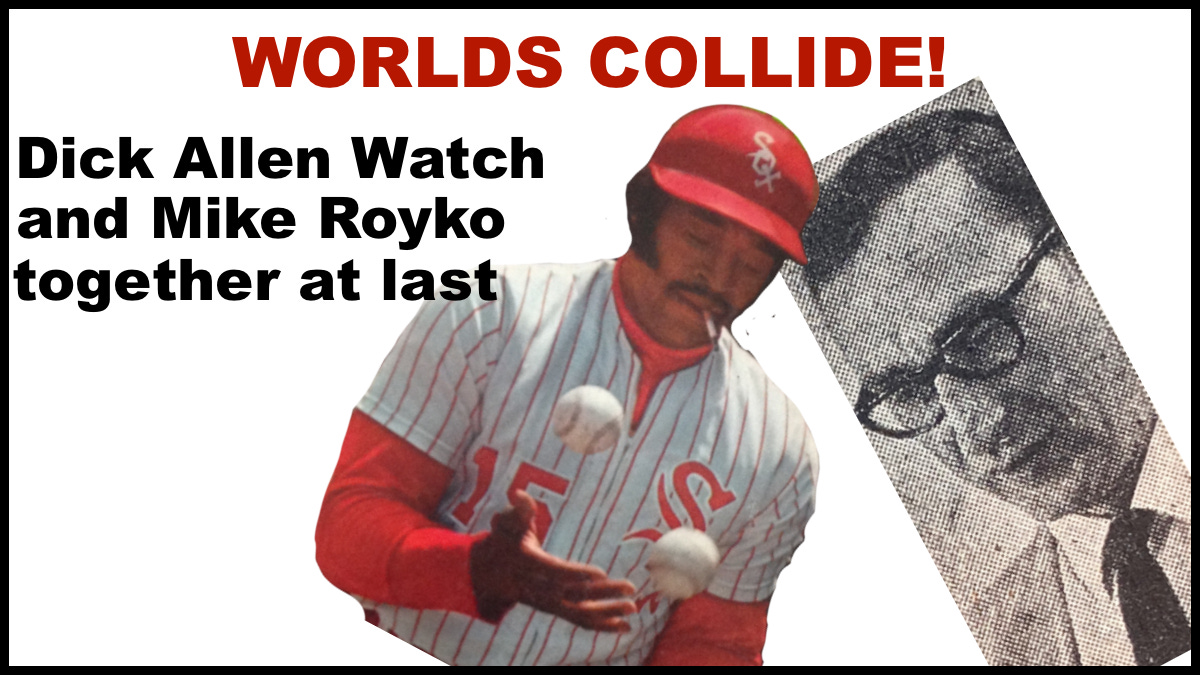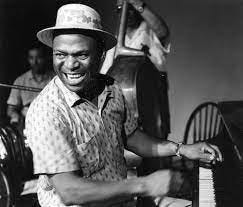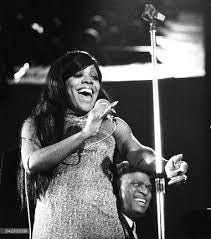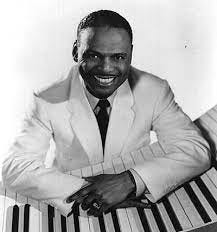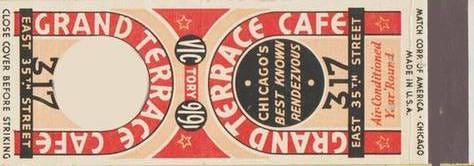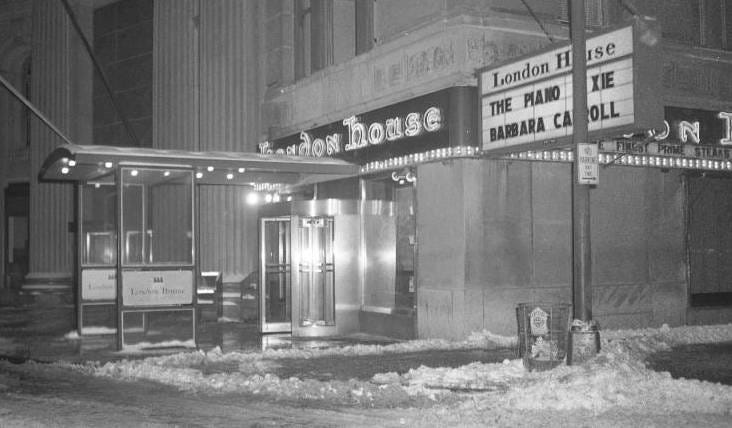THIS CRAZY DAY 1972: Look up there, it's the BGA!
Weekly Compilation April 24-30, 1972
To access all contents, click HERE.
Why do we run this separate item peeking into newspapers from 1972? Because 1972 was part of the ancient times when everybody read a paper. Everybody, everybody, everybody. Even kids. So Steve Bertolucci, the 10-year-old hero of the novel serialized at this Substack, read the paper too—sometimes just to have something to do. These are some of the stories he read.
April 24, 1972
Chicago Today: Stanky’s feats
April 24, 1972
Chicago Daily Defender: The black watch
Kenwood hi killing; old scripts actors
by Renault Robinson
The investigation into the shooting of former Marine Cornell Fitzpatrick inside Kenwood High School on Feb. 15 by an off-duty Chicago cop working as a security guard is heating up.
On April 15, the Defender’s Robert McClory reported that Illinois Rep. Robert Mann and prominent Chicago civil rights attorney Marshall Patner held a press conference at the Alliance to End Repression headquarters to condemn Cook County Coroner Andrew Toman’s selection of Martin Gerber as the special deputy coroner overseeing the Fitzpatrick case. Gerber wasn’t, as Toman had promised, from a pre-approved list by the Chicago Bar Association. And as McClory wrote, Gerber is “the same special deputy coroner…who headed the jury which exonerated the police in the 1969 killings of Fred Hampton and Mark Clark.”
“Once again the City of Chicago stands accused—the mayor, the police chief, the state’s attorney and the coroner are the same actors in the same play,” writes Renault Robinson, co-founder of the Afro-American Patrolman’s League. “‘The Killing and Cover Up of Cornell Fitzpatrick,’ starring Martin Gerber with stars white Patrolman Bernard Martin and special guest the ‘Drop Gun.’ This is a repeat performance—the actors are basically the same. The guest star is always a white policeman, the victim is always a black young man. Any black person in the city of Chicago can give you the outcome of the play (An American Tragedy).”
The off-duty cop, Bernard Martin, claimed Fitzpatrick had a gun, and that he shot Fitzpatrick in self-defense. Robinson writes that the AAPL investigated, and “witnesses stated Fitzpatrick had no gun.”
Toman, writes Robinson, is “indicative of the kind of arrogance that developed when politicians became so entrenched in public office that they do not have to respond to the cries of the people, on the order of political bosses. It isn’t just the coroner, however, it is the police department officials, the states attorney, and the whole political system in Chicago. None of which responds to blacks. Ask your black politicians, if you can find them.”
“At this point we do not expect anything but another ‘whitewash’ from the Daley-Toman-Gerber-Conlisk-Hanrahan team….But the coroner’s inquest will not be the end of the Cornell Fitzpatrick-Bernard Martin case.”
April 24, 1972
Chicago Daily News
April 24, 1972
Chicago Daily News: Glum Gordon reports to jail
by Betty Washington
Bears star Dick Gordon started his 15-day sentence for failing to file tax returns for three years—though two counts were dismissed, so technically, just for not filing in 1969.
He is not feeling good about Chicago. “Chicago hasn’t been a good place for me,” he told reporters.
But as always, he looked sharp. Betty Washington’s description: “Gordon wore a stylish blue denim suit with flared pants, a red shirt and carried a white vinyl handbag.” From the picture, I would call that a sports bag.
April 24, 1972
Chicago Today: ‘Workers’ strain to look busy
Chicago Today teamed with the BGA for another fun investigation—savor this delicious helping of government waste!
“City employes at O’Hare International Airport work harder at pretending they’re working than at actually washing windows, floors and ceilings and performing other routine custodial tasks,” the investigation found.
Yum!
“Maintenance personnel in white, khaki or blue uniforms watched airplanes, ogled girls, took coffee breaks and looked for abandoned change in pay phones.”
Oh, Younger Readers, that was a thing! You probably don’t even know what a payphone looks like. But if you tried to make a call and nobody answered the phone, for instance, the coins you deposited at the top of the payphone in those little round holes (see below) were returned through a slot at the bottom. Surprisingly, if you stuck your finger in there, you often found a few coins.
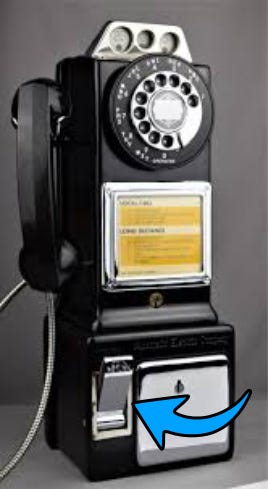
“Several employees were clocked spending only an hour working in the course of a seven- or eight-hour work day.”
“The examples of loafing explain, in part, why payroll and custodial costs at the world’s busiest airport have doubled in the last five to six years….From 1966 to 1972, the budget for O’Hare has tripled, from $12 million to $35.8 million…and janitorial services have doubled, from $1.09 million in 1966 to a projected $2.1 million for 1972.”
“Investigators who observed employes at O’Hare say that the longest distance between two points is the ‘O’Hare shuffle’—which the employes use to meander from one place to another.”
Just one of the priceless anecdotes:
“In one instance, a janitor sleeping in a storage closet in the women’s restroom was awakened by a maintenance man who yelled into the rest room for her.
“She cleared the rest room, told the men to come in and asked them to fix a toilet which, she said, had been leaking for two weeks. They ignored her request and left.
“‘They never do nothing,’ she grumbled. ‘All they do is walk around, walk around.’”
Here’s the headline for the sidebar. We’ll stop here though, because we’ll all get a sugar high if we keep this up.
See why I can’t get enough of Chicago Today?
April 24, 1972
Chicago Daily Defender: Find Your Name Contest
By now you’ve figured out that all the newspapers have contests going on, all the time. See March 3 for a sample of Chicago Today’s Social Security Sweepstakes, the nuttiest contest of all. The Defender does a regular beautiful baby contest, but lately they’ve also got a new one:
April 24, 1972
Chicago Daily News: Allen leads surge as Sox win 5th in row
by Dave Nightingale
“Today’s White Sox fable, kiddies, can be called ‘Richie Allen and The Golden Egg.’
“Richie, you’ve met. He plays first bat…er, base…for the Sox and it was his homer, triple and single that almost singlehandedly shoved the South Siders past Kansas City 3-2 on Sunday and into second place in the American League’s Western Division.”
Allen’s eight-inning single “raised Rich’s batting average to a cool .452”.
April 24, 1972
Chicago Today: Pucinski comes out fighting
by Michael Hirsley
Stick around for the fight.
U.S. Rep. Roman Pucinski, as reliable a member of Mayor Daley’s Democratic Machine as you’re likely to find, is giving up his seat in an unlikely bid to beat incumbent Republican U.S. Senator Charles Percy.
So even though the proposed Crosstown Expressway is a pet project of Mayor Daley’s, the growing and furious opposition by hundreds of Chicagoans whose homes would be razed for yet another expressway is making Pucinski squirm. That’s a lot of votes.
Today, Michael Hirsley covers a meeting outside Pucinski’s office at 6200 N. Milwaukee with a boisterous crowd of about 100 members of the Anti-Crosstown Coalition. They’re led by Father Leonard Dubi, co-chairman of the then-prominent community group Citizens Action Program (CAP).
Pucinski “Accepted the group’s challenge to participate in the Anti-Crosstown motorcade march-referendum May 21 ‘to show I’m not influenced by Mayor Daley’s support of the Crosstown,” but he “refused to sign a symbolic contract declaring his opposition to the Crosstown, for which he was jeered” by the crowd.
Hirsley notes that Sen. Percy’s stand on the Crosstown is equally flabby. Pucinski at least said his office had researched the issue and found problems, including the point that displaced manufacturers would mean a loss of 4,500 local jobs if the companies aren’t given enough economic incentives to rebuild nearby.
Finally, Father Dubi “called for Pucinski to reveal his and his family’s financial holdings”. But “Pucinski retorted he would discuss that when Dubi revealed where he got enough money for a recent European vacation.
“He said the group leaders were seeking confrontation, and shouted at Father Dubi, ‘Say, if you weren’t a priest, I’d punch you right in the nose!’
“‘Go ahead! Go ahead!’ shouted Father Dubi”.
The meeting ended shortly thereafter.
Chicago priests—ya gotta love ‘em. There’s a profile of Father Dubi coming up in May, so stay tuned.
See why I can’t get enough of Chicago Today?
If you’re a regular THIS CRAZY DAY reader, you’ll probably want to follow Mike Royko 50 Years Ago Today too.
April 25, 1972
Chicago Today: Daley denounces O’Hare expose
Toot toot! The Daley train is running right on time.
“Mayor Daley denounced reports by CHICAGO TODAY and the Better Government Association of city payroll padding at O’Hare International Airport as a ‘publicity-seeking venture’ showing ‘blatant disregard for the facts.’”
Mayor Daley called a press conference for this purpose.
Mayor Daley’s statement criticized the investigation for not questioning the consulting company that, by ordinance, prepared a recommended budget for O’Hare. Mayor Daley also claimed the investigation didn’t take inflation into account. Mayor Daley did not address, however, the janitor sleeping in the closet in the ladies room. Or the leaking toilet that didn’t get fixed. Or the O’Hare shuffle.
“O’Hare is open 24 hours a day, seven days a week to serve the general public—30 million passengers a year—far in excess of traffic at the Pentagon,” Mayor Daley said, though I think these quotes are very cleaned up.
Mayor Daley said the airlines haven’t complained about the workers. He “appeared upset and jousted with reporters who tried to query him on the airport issue.
“He finally waved the [consulting company report] in his hand and asked, ‘What kind of reporting is this when the questions were answered by some of our staff and never printed?’”
I can’t get enough of Chicago Today.
April 25, 1972
Chicago Daily Defender: Conlisk weighs 6 demands on cops
By Tony Griggs
U.S. Rep. Ralph Metcalfe, previously a loyal Daley Machine member, has broken from the organization on the issue of police brutality. Metcalfe is a legendary Black Chicago politician who succeeded the equally legendary William L. Dawson in Congress after serving a stint as a South Side alderman. Most interestingly, perhaps, Ralph Metcalfe was an Olympic track and field sprinter who held a world record in the 100-meter dash, and came in second in the 1932 and 1936 Olympics—the latter, running second to Jesse Owens in Berlin.
Yesterday, Metcalfe met with Chicago Police Supt. James Conlisk at police headquarters, along with Ald. Tyrone Kenner (3rd) and 15 more Black community leaders.
“During the hour-long meeting….Metcalfe made the following demands concerning ‘the increasing rise of police misconduct toward the decent black people of this city.’”
The demands include terminating a Special Operations Group, establishing a Citizens Board in each police district, appointing Blacks to policy-making positions in the police department, recruiting more Black cops, promoting more Black cops, and doing all of it by May 31, 1972.
If not, said Metcalfe, “it is incumbent upon us then to go back to the community and set up techniques of survival for ourselves—and this, we are prepared to do.”
Surprisingly perhaps, Conlisk accompanied Metcalfe and the rest of the group downstairs to speak with reporters, and essentially agreed to address the demands—though no details of exactly what he planned to do, or when, are mentioned.
April 25, 1972
Chicago Daily News: Secret Kissinger trip to Moscow!
by Peter Lisagor
Another secret trip! This time, to Russia. And he isn’t even Secretary of State yet.
“Presidential assistant Henry A. Kissinger has just returned from a secret four-day visit to Moscow to confer with top Soviet leaders on international problems,” writes Peter Lisagor, the News’ Washington bureau chief and arguably most respected reporter, for whom the Chicago Headline Club’s annual awards are named. When Nixon went to China, the News sent Peter Lisagor.
You can tell Kissinger is just loving all this attention—and he will be all over the papers this week.
“Kissinger said he had discussed the whole range of Soviet-American relations, with particular attention to those of immediate interest.”
As if that means anything. No disrespect to Lisagor. You see how Kissinger got where he was.
“He declined to elaborate on the details of his talks, but said, ‘We are at the moment in a very delicate phase of international relations.’”
It’s like Kissinger is a character on “Veep” 40 years early.
“The White House had reported through the weekend that Kissinger was at Camp David with Mr. Nixon. The secrecy that prevailed during Kissinger’s absence recalled similar missions by Kissinger. He made a secret trip to Peking last summer to set up Mr. Nixon’s China visit, and he made 12 secret trips to Paris for private negotiations with North Vietnamese delegates.”
April 25, 1972
Chicago Daily Defender: Dentists back Dr. Claiborne
by Michael L. Culbert
“The Lincoln Dental Society yesterday issued a statement condemning the Chicago Police Department for its ‘cruel and unnecessary treatment’ of a Southside dentist.
“The victim, Dr. Daniel L. Claiborne, 71, 9239 S. Forrest ave., is presently in the intensive care unit of Provident Hospital where his condition is listed as poor.”
Dr. Claiborne apparently suffered a stroke while driving, and was “arrested by Kensington District police officers on charges of drunken driving”—then held at the station for about five and half hours before his wife, Mrs. Clara Bell Claiborne, was called to pick him up because he was “in a stupor but not drunk”.
April 25, 1972: The Mighty IC
Chicago Daily News: Daley hails 36-story hotel near lake
by Robert J. Herguth
Mayor Daley ceremoniously breaks ground for the $40 million, 36-story Hyatt Regency Chicago, “apparently…the first big downtown convention hotel built here since the 1920s,” writes Robert Herguth.
Herguth has to explain where this is happening, because in 1972 almost the entire area between Randolph and the Chicago River east of Michigan Avenue is a vast rail yard for the Illinois Central—basically this postcard below, with the addition of the almost-finished Standard Oil Building just to the right of the Prudential Building.
The hotel is being “built on air rights south of the Chicago River on an extended Wacker Drive, two skyscrapers east of Michigan Av.,” he writes. That would be the Illinois Central Railroad’s air rights.
Mayor Daley, who is pushing for an airport in the lake eight miles off 55th St. and who opposes Illinois Rep. Robert Mann’s proposed Lake Michigan Bill of Rights, takes the opportunity to pose as an environmentalist.
“Our plan for the future is to open up the lake” for the people, he tells reporters. “No one has defaced our lakefront” since Daniel Burnham’s Plan of Chicago, he insists.
“‘Why shouldn’t people live in the center of our cities?’ asked Daley. ‘Why should they travel an hour on expressways…with all the tension’ such driving involves.”
Again, this is a groundbreaking for a hotel. Not a subdivision. But as we learned earlier this month when the City Council approved spending $2 million to create a three-level extensions of Randolph and Wacker from Michigan Avenue to Lake Shore Drive plus Columbus Drive from Monroe to the river, there are plans afoot to build up to 33 high-rises. Those plans are bitterly opposed by independent aldermen, state Rep. Anthony Scariano and Robert Mann, and community groups like Citizens for a Better Environment…and vigorously championed by Mayor Daley and his allies.
See Mike Royko’s April 26 column for more on Mayor Daley and lakefront development. As Mike observes of Mayor Daley’s lakefront preservation so far, “The Normandy invasion left fewer scars on the coast of France.”
Mike also notes Mayor Daley’s declaration that his plan is to “open up the lake” for the people.
“I’m sure he means it—but which people?” writes Mike. “Does he mean the Illinois Central Railroad people, who have been selling off land to high-rise people?”
Back to the groundbreaking:
“Daley and other dignitaries broke ground by shoveling dirt from a bucket lifted 30 feet in the air via crane to the level of the outside balcony of the 111 E. Wacker Building. Then they scattered the dirt back to the ground below.”
See Mike Royko’s April 26 column on Mayor Daley’s groundbreaking at Mike Royko 50 Years Ago Today!
April 25, 1972
Chicago Daily News: Eunice hits liberated moms
“Mrs. Eunice Kennedy Shriver says women’s liberation is partly to blame for the neglect of children’s minds at home.”
….“‘Women’s lib hasn’t helped in child-rearing,’ the sister of the late President said.
“‘It has been good in job discrimination and things like that, but it has resulted in the downgrading of the whole concept of motherhood. The idea now seems to be that housewives should do anything to get out of the house, leaving the children’s minds neglected.
“‘Three-fourths of all mental retardation could be prevented by giving children proper stimulation during the first five years of life,’ Mrs. Shriver said.”
April 25, 1972
Chicago Daily News: Stretch your money column
Does it pay Mom to go back to work?
By Dan and Michele Miller
The Millers consider the economic implications of a mother going back to work, which in their scenario means “it’s only three days a week, but she’ll earn $50 for her part-time employment, and that’s $50 more a week than she had before. Or is it?”
The Millers think up every possible expense to eat up Mom’s salary: transportation, new wardrobe (which will mean “extra upkeep”), new food costs, childcare, taxes, increasing the family’s overall tax liability. And then they really drill down.
Focusing on the fictional Mr. and Mrs. John Litton, Mrs. Litton’s “clothing expenses will soar around 25 percent, since her existing wardrobe and its upkeep probably aren’t sufficient to keep her groomed as a working woman. Food costs will grow about 10 per cent to cover added outlays for eating out (‘I’m bushed. I’ll treat for dinner.’) and buying convenience foods (cooking bags, some canned food, skillet dinners).
What about union dues? What about “the inexhaustible flower fund or whatever at her place of employment.”
And what if she actually has money left after all that? The family better not use it as normal income, because “what happens when the worker becomes pregnant or decides she doesn’t like working after all? It means a cut in pay and an immediate reduction in the standard of living.”
So the headline was a rhetorical question.
April 25, 1972
Chicago Daily News
1972 is smack in the middle of the Margarine Age. It’s not just cheaper. It’s the only way to avoid a heart attack. And in 1972, heart attacks seem to be coming for everybody. There are SO many brands of margarine in 1972.
April 26, 1972
Chicago Daily News: Daley, Despres in a landmark Council battle
By John Linstead
Oh boy, Mayor Daley versus progressive firebrand, pain-in-Mayor Daley’s-mistletoe, legendary 5th Ward Ald. Leon Despres during a City Council meeting!
“The question of immediate City Council consideration” of the Monadnock Building for landmark designation “sparked a lively verbal battle between Mayor Richard J. Daley and Ald. Leon Despres (5th),” writes John Linstead.
This is fun, because we know the Monadnock Building is still there.

The north half of the Monadnock Building was designed by Chicago’s arguably most famous architect, Daniel Burnham. The south half was designed by nearly as famous Holabird & Roche. Among other things, the Monadnock was/is the tallest building ever with load-bearing brick walls. It’s pretty darn historic, although it’s. what you might call “muscular” as opposed to beautiful.

Despres accused Mayor Daley of leaving the Monadnock designation bottled up in the Cultural and Economic Development Committee for two years through “lazy conscious inaction under your direction.”
“Don’t get excited,” said Mayor Daley.
“I don’t intend to have anyone shut me up,” Despres “fired back.” “You’re suppressing freedom of discussion in the council and I will not tolerate it.”
Mayor Daley said if the majority of the Council wanted to discuss the Monadnock Building, he’d allow it.
“But the majority is against me,” Despres interrupted.
“That’s right,” said Mayor Daley.
BAM.
I’m imagining he rapped his gavel, but that is admittedly not in the article.
April 27, 1972
Chicago Today: Rick Talley column
On second thought, Sox will win it
“Please revise my prediction.
“The White Sox won’t finish second in their division this season. They’ll finish first.
“They’ll also win the American League playoff, the World Series, and perhaps the Stanley Cup, if you’ll issue them some skates.
“That’s the provincial pick I forwarded to a Sporting News poll early in March. That’s how impressed I was with the whole Sox thing in Sarasota. But then, when Richie Allen didn’t show up until strike time, I backed off and went for Oakland.
“That was dumb. The White Sox are going to win.
“So are the Cubs. Whee. A northside-southside World Series. I wonder if the town can stand the strain.”
Second half of the column: Rick Talley interviewed Floyd Patterson the other evening. He’s now 37, “but still fighting because he loves to fight, not because he has any out-of-shape dream of winning the world heavyweight championship for the third time.”
Patterson explained “the infamous mustache-and-beard disguise he wore after being knocked out in the first round in Comiskey Park by Sonny Liston on Sept. 25, 1962….Floyd walked thru the lobby unnoticed wearing his disguise.”
Patterson says he also had the disguise ready when he fought Ingemar Johannson for the third time, but didn’t need it, since he won that bout by a knockout. Talley asks why Floyd needed a disguise at all.
“Because I let so many people down, I was ashamed. But, you know, I’d do it again. I’m not ashamed that I was ashamed.”
April 27, 1972
Chicago Daily News editorial
April 27, 1972
April 28, 1972
Big day, even for 1972!
Wish you had a basic idea of how Chicago started, but not up for cracking a history book? I get it. Here’s a fun way to learn the basics—Part 3 of our Wrigley Building Notes Chapter: When Chicago Wasn’t Chicago. It cites several terrific books for further reading, when you’re ready.
April 28, 1972
Chicago Today: Action Line
Recall that Chicago Today’s Action Line is that paper’s service column, like the Daily News’ Beeline. But like everything else about Chicago Today, it is often much saltier and unpredictable. At the end of most columns, Action Line includes a “Sound Off” where a reader expresses an opinion. Today’s:
April 28, 1972
Chicago Daily News: $1,000 reward offered in search for Nickel
by Tony Fuller
The Chicago Landmarks Preservation Council offered $1,000 for “information leading to the discovery” of architectural photographer and Louis Sullivan expert Richard Nickel, believed crushed in the rubble of Adler & Sullivan’s Old Stock Exchange Building.
The Stock Exchange is currently under demolition, since preservationists lost a bitter struggle to save it last fall. Nickel was salvaging priceless Louis Sullivan ornamentation inside the building when it’s “feared that he was buried in a cave-in.”
As the Daily News reported last week, “Nickel…was seen in the building last Thursday shortly before a floor and wall gave way and crashed into the basement area. His hard hat and briefcase were discovered by Canine Unit dogs Monday, placed neatly on a table in part of the second floor.”
Workers combed through the wreckage for days but found nothing, and on April 18, the search was called off and demolition resumed.
“Richard Miller, president of the council, said the reward was being offered in hopes someone who saw Nickel at the demolition site or elsewhere prior to the time he was reported missing would come forward.
“Nickel was last seen at the home of architect John Vinci, an associate, where he had gone to get some block and tackle equipment.”
“Miller said Nickel was a ‘remarkable person who probably knew more about the work of Sullivan than anyone in the world. We cannot replace what he knows. When it comes to a sensitive restoration of a Sullivan building, you could spend $5 million and still not replace what he knows.”
Last week’s reporting noted that Nickel had been working on a definitive book on Sullivan’s work for 15 years. The book would be finally finished, beautifully, in 2010 by the Richard Nickel Committee. Here is a slightly worn copy of "The Complete Architecture of Adler & Sullivan" by Richard Nickel and Aaron Suskind with John Vinci and Ward Miller.
April 28, 1972
See coverage of Mike’s April 28th column here in Mike Royko 50 Years Ago Today!
April 29, 1972
Chicago Daily Defender: ‘Fatha’ Hines jazz is super great at the Loop’s famed supper club
by Earl Calloway
Earl “Fatha” Hines is starring at the London House through May 14, writes Earl Calloway, calling Hines “the greatest jazz innovator and creator of modern jazz”.
Hines is “in the land of his beginnings” here in Chicago, writes Calloway, “where more than fifty-one years ago he performed with such greats as Louis Armstrong, Carroll Dickerson, Sammy Stewart” and led “his own big band at the Grand Terrace on South Parkway (now King Dr) beginning in 1928.”
Calloway reports he had a great seat to observe Hines: “The real fascination about his performance came in the manner he improvised with octaves, tenths and other intervals that formed the ground-bass or the foundation for his melodic or harmonic movement in the right hand.”
“Whether ripping through the ‘St. Louis Blues,’ ‘Summertime,’ or Eubie Blake’s ‘Memories of You’ Fatha Hines’ playing coaxes luster from the ebony Steinway keys”.
“Bobby Mitchell’s performance on trumpet was gorgeous and lyric as he made a stunning entrance into the performance from the rear of the London House.”
Per discogs.com, Bobby Mitchell left Hines for Count Basie by 1976. You can definitely hear him on Count Basie’s 1976 album “I Told You So.”
And Marva Josie sang vocals with “consummate artistry,” including “Made Me Leave My Happy Home” and “Misty.”
Marva Josie only gets a sentence here, but deserves much more. What a voice! Here’s a YouTube clip of her full 1973 album “This is Marva Josie” with the Earl ‘Fatha’ Hines Orchestra. Though you should buy it, of course. Check her out on Spotify too.
And per Wikipedia, Fatha Hines had plenty of Chicago connection, as Calloway writes. Hines moved here in 1925 at 21—already a professional musician who’d been on the road since 17. Wikipedia says Hines met Louis Armstrong “in the poolroom of the Black Musicians' Union, local 208, on State and 39th in Chicago,” and played with Armstrong in Carroll Dickerson’s band at the Sunset Cafe, which closed in 1927.
The Sunset Cafe was located at 315 E. 35th St. The former Sunset Cafe’s building at 313-319 E. 35th is on the Chicago Landmarks List on the Landmarks Commission website, though it’s unclear whether it’s been approved by the City Council. The building segued into an Ace Hardware store at some point, and is now the Urban Beautique.
The Grand Terrace was at least nominally owned by Ed Fox, who turns up in the Defender archives quite often, and located first on South Parkway (later renamed Martin Luther King Drive) at either 40th St. or nearby Oakwood—both descriptions are used in different places. Wikipedia states that Hines became bandleader of his own orchestra at the Grand Terrace in December 1928, and that the club was actually owned by Al Capone:
From the Grand Terrace, Hines and his band broadcast on "open mikes" over many years, sometimes seven nights a week, coast-to-coast across America – Chicago being well placed to deal with live broadcasting across time zones in the United States. The Hines band became the most broadcast band in America.
Checking into the Grand Terrace via the Defender archives, the original Grand Terrace on South Parkway closed in January 1937, then reopened later that year in the old Sunset Cafe building, but with Fletcher Henderson.
The Defender’s article on the closing of the original Grand Terrace is fascinating:
“The ripping off of the $7,500 carpets by Ed Fox last Sunday morning from the floors of the Grand Terrace Cafe, Oakwood Boulevard and South Parkway, marked the end of one of the grandest night life spots the middle West has ever seen,” wrote James J. Gentry on January 30, 1937. “Old friends, who have dined and wined at the Terrace since its founding eight years ago, were on hand to see their rendezvous for the last time. Ed Fox gripped their hands in a last farewell.”
“A deep, sad note struck when dapper Earl Hines made the announcement. It wasn’t just one of those nightly announcements, but one which he, more than any one else regretted. Reminiscing of past years, Earl played upon those ivory keys in a fashion never seen before. Though the next morning the Grand Terrace would be no more, those who gathered on that eventful night were witnesses to one of the finest programs ever presented anywhere.
“The songster, Ida James, sang softly, sweetly, with sorrow only in her face, not in her voice. Elma Turner, taptress spanked the boards harder than the Three Thunderbolts at the Swingland. Alma Smith also outshone herself with her delightful numbers. Keeping their part of the closing drama in tune with the rest, Sonny and Sonny, dancing demons, set a new score for speedy harmony.
“Earl Hines and his boys quit Chicago Tuesday for a long tour, while the rest of the gang went hither and yon. Construction was begun Monday on a new movie house on the same site as the Terrace.”
Thanks to John Chuckman’s Photos on Wordpress, we have a Grand Terrace matchbook from the new location:
And what about the London House, where Hines performed in 1972? Located in the London Guaranty and Accident Company Building at Wacker and Michigan—which now houses the London House Hotel—the club opened as a swank restaurant in 1946 and turned into one of the hottest jazz clubs around in 1955.
But the days of jazz were numbered, even as Earl Hines appeared at the London House in 1972. The club would close in 1975.
Thanks YET again to John Chuckman, here are some amazingly atmospheric shots of the London House.

April 29-30
Chicago Daily News: Lu Palmer column
Why black vets plan protest march
“Black veterans, becoming more and more restless and angry because of readjustment problems they face, plan a Veterans March on Washington late in June,” writes Lu Palmer this week.
“The march is being organized by the Concerned Veterans from Vietnam….Plans call for conferences to be set up with every official the veterans can pin down,” especially President Nixon.
The veterans will present a “Veterans’ Bill of Rights,” including a demand to grant “amnesty” for less-than-honorable discharges and convert them all to honorable. The less-than-honorable discharges, as Palmer has written before, “not only cut off veterans’ benefits but also block the vet from decent employment. Most employers require an ‘honorable discharge’ as a condition of employment.”
“The plight of the veteran is ironically consistent with the immorality of the war which they have fought,” writes Palmer. “Most of the vets who will march on Washington served in Vietnam….Black servicemen understood that there is a tyranny at home that black people have been fighting from the days of slavery. Perhaps some of them were naive enough to think that because they served gallantly on the field of battle, America would treat them gallantly when they returned.
“But veterans today are treated more shabbily than ever before in our history….at the least, it will tell the world that America is turning its back on her fighting men.”
April 30, 1972: The Mighty IC
Chicago Tribune
by William Juneau
Last month, the Illinois Commerce Commission granted the Illinois Central its wish: a 7% fare increase on its commuter train line serving the South Side, including Hyde Park and Roseland.
But like a bad fairy godmother, the ICC also ordered the IC to “repair and maintain existing stations, put its signal system into a reliable condition, modernize old commuter cars, and see if new train scheduling is needed,” per today’s article—which is a more detailed accounting of the ICC orders than we’ve seen before.
That had to be a response to an earlier Tribune interview with nine top IC executives. The IC executives blamed the current avalanche of IC train breakdowns and delays on its old train cars, but also admitted that they decided four years ago “that no major overhaul work or other major repairs would be made to the old commuter cars. Instead of spending money to rebuild the old cars for 10 to 15 more years of operation, the Illinois Central officials specified that the cars be kept running on a safe basis at a minimum of maintenance expense.”
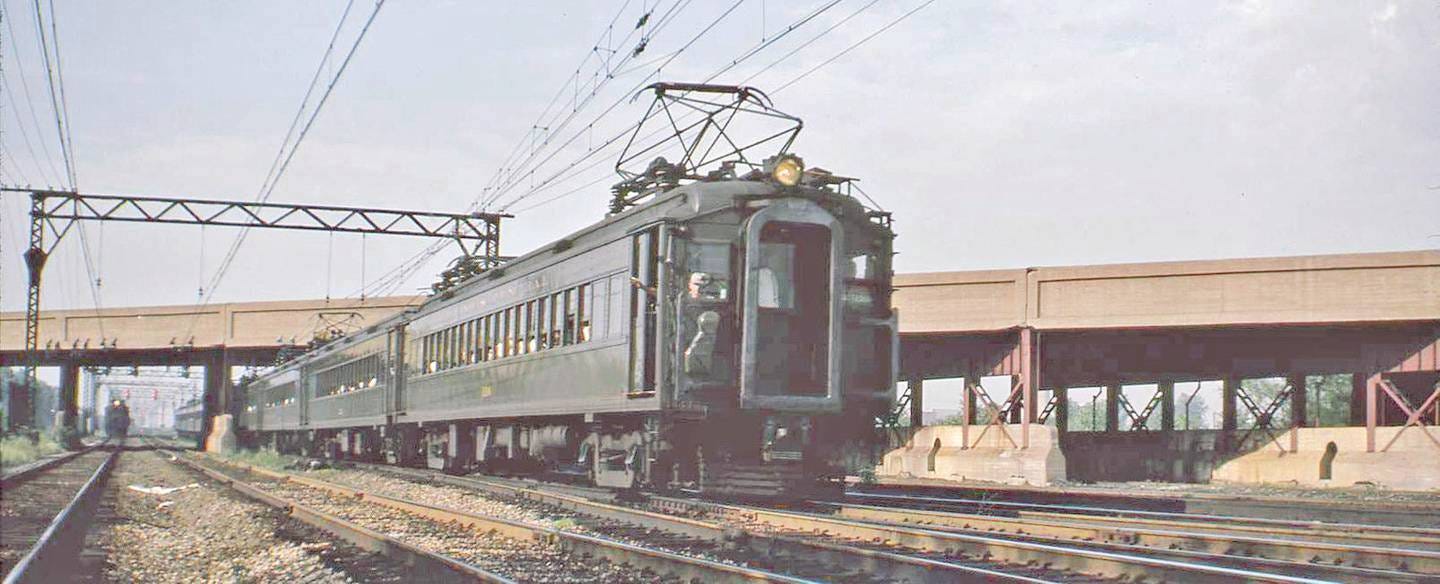
More ominously for the IC, the ICC set May 9 for a new hearing into “the I.C.’s relationship with its parent company, Illinois Central Industries, Inc., to determine if the conglomerate has worked to the detriment of riders.”
The hearings will take place in the State of Illinois Building, 160 N. LaSalle.
“Cyrus J. Colter, a commissioner, said that the ICC will examine the programs and expenditures for the improvement of service by the railroad, transactions between the railroad and parent company, and utilization of proceeds from the sale of assets.”
“‘Is there an effect of the conglomerate on the commuter operation?’ asked Colter. ‘We don’t know the answer, but we want to find out. It could be that the conglomerate, which also operates soft drink, foundry, and panty hose companies, causes an artificial burden to be placed on the commuter operation.’”
And more IC fun!
Chicago Tribune
no byline
Many independent politicians, as well as groups like Citizens for a Better Environment, are working to stop massive high-rise developments using the air rights for land owned by the Illinois Central in two key downtown lakefront locations: the old site of Fort Dearborn, from Randolph to the river east of Michigan Avenue…
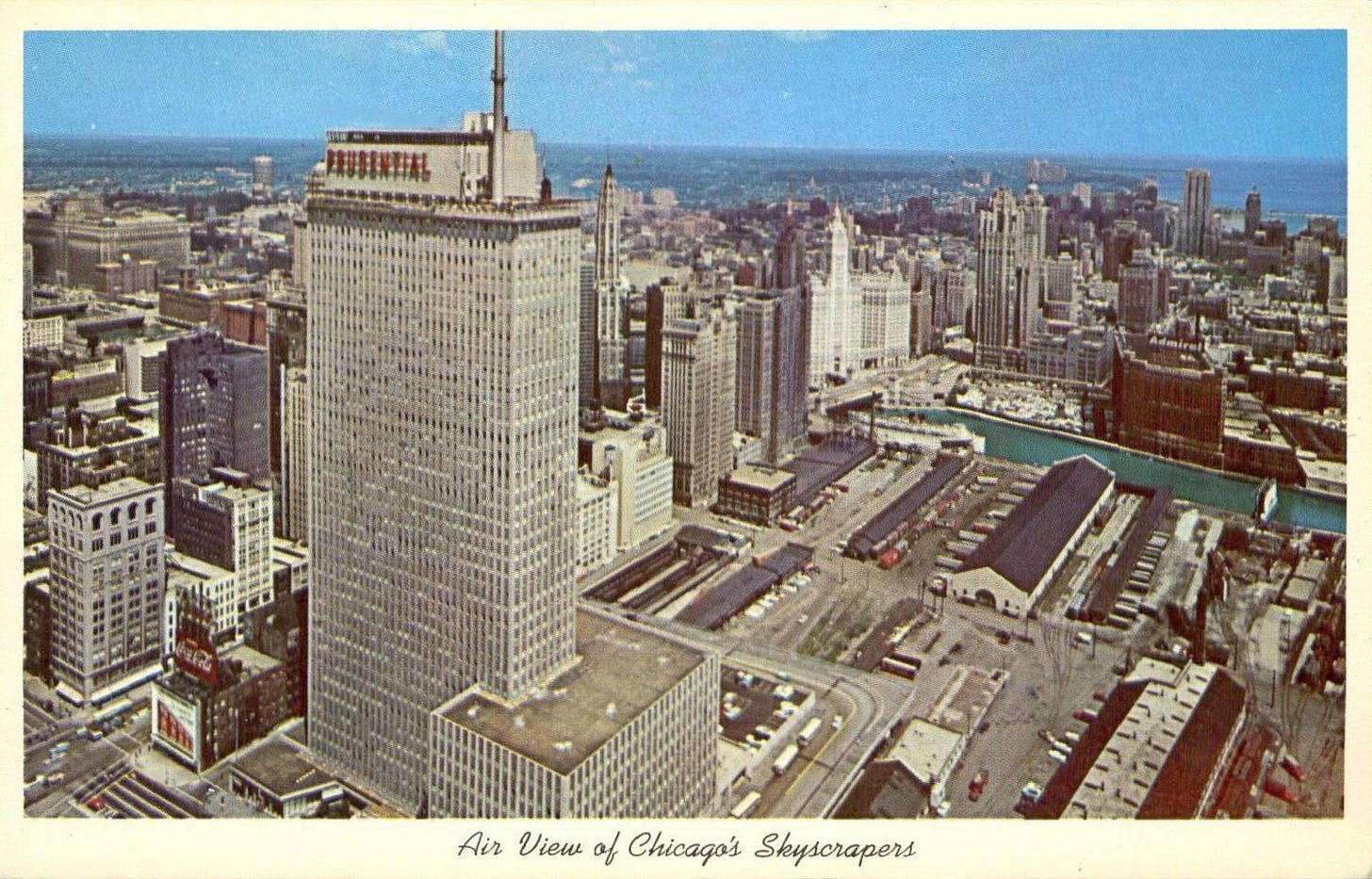
…and the south end of Grant Park, from Michigan Avenue to the eastern edge of the IC train yards, extending south from Roosevelt Road at least as far as McCormick Place at 22nd Street.
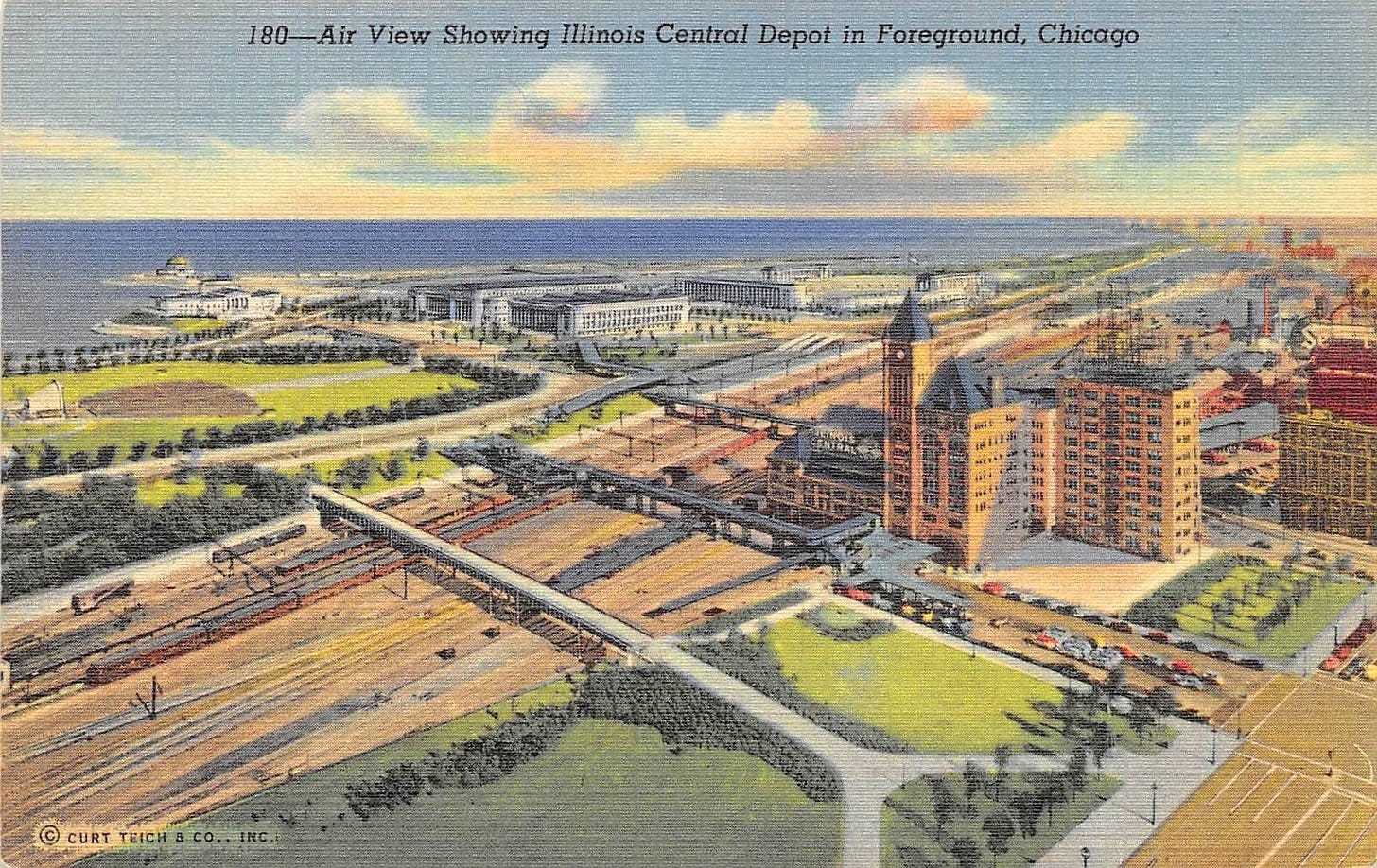
Today’s Tribune article, with no byline, mysteriously declares with no attribution that the city has guidelines in place for the IC property south of 12th Street that will require developers “to maintain east-west access across the project at many points using either parks or streets which will lead to the Lake Michigan shoreline.”
These guidelines are supposedly “the same concept of planning used for the Illinois Center project between Randolph Drive and the Chicago River, east of Michigan Avenue.”
However, as we read on April 5-6 in coverage of the last City Council meeting, all the independent aldermen believe the city is about to build a wall of high-rises on the site of old Fort Dearborn and call it “Illinois Center.”
“This is not going to make Chicago great, but grotesque,” said Ald. Seymour Simon.
Today’s anonymous Trib article, again with no attribution, says “The density of the project” south of Grant Park “will be varied, preventing the construction of a wall of high rises along the length of the 104-acre street of land. Two high-density areas—near 11th Place and near McCormick Place—will be separated by low density areas.”
Per this article, the IC and Ogden Development announced they’ll build a hotel, apartment buildings, and an office building on the 12 acres between 11th and 14th.
“A high-density development is planned around McCormick Place to the Sevenson Expressway. The density is lowered again south of the Stevenson Expressway where plans are being formulated for an extension of Michael Reese Hospital complex, housing and shopping.”
Did you dig spending time in 1972? If you came to THIS CRAZY DAY IN 1972 from social media, you may not know it’s part of the novel being serialized here, one chapter per month: “Roseland, Chicago: 1972” —FREE. It’s the story of Steve Bertolucci, 10-year-old Roselander in 1972, and what becomes of him. Check it out here.



